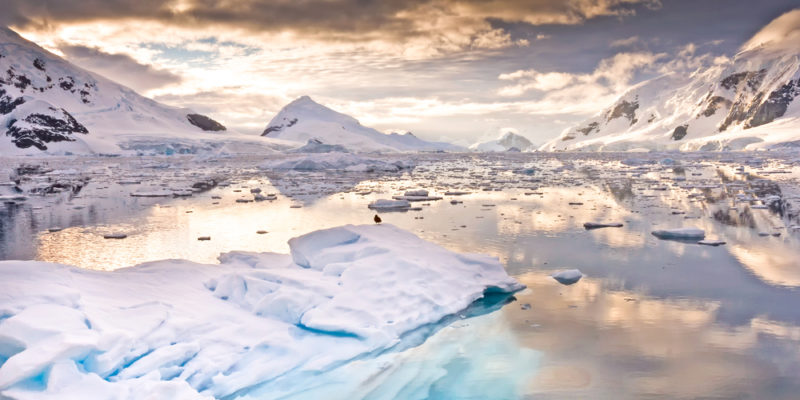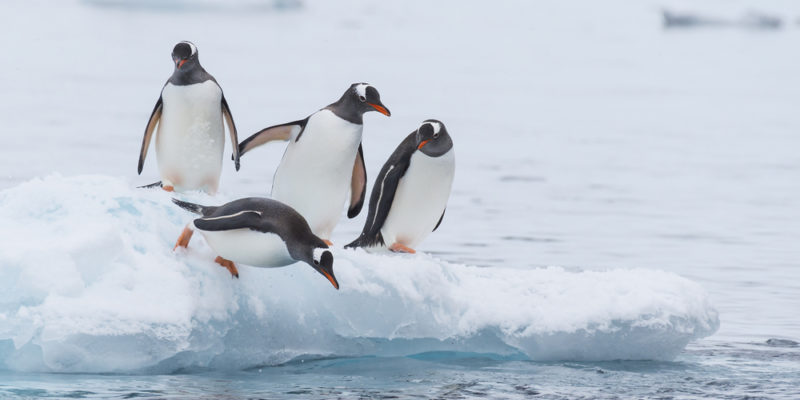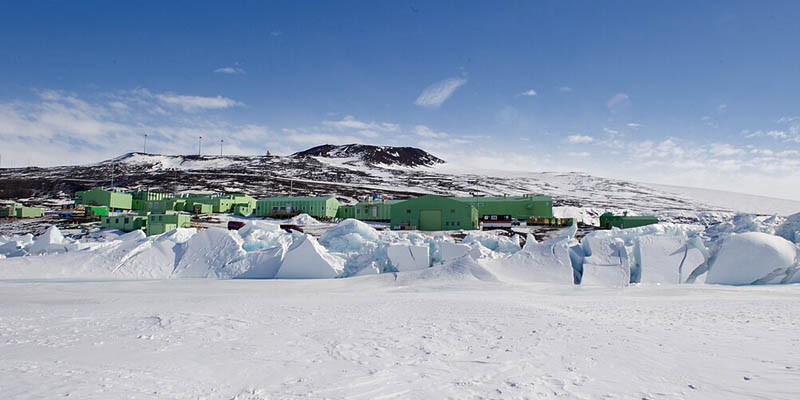We explore Antarctica, and describe its climate and relief. In addition, we discuss the economy and history of this continent.

What is Antarctica?
Antarctica is one of Earth's six continents and the fourth-largest in size. Spanning an area of nearly 5.4 million square miles (14 million km2), it accounts for 9.4% of the planet’s total land area.
Due to its geographical position, Antarctica experiences extremely cold climatic conditions with average temperatures ranging between 14 °F and -22 °F (-10 °C and -30 °C). Moreover, it is the driest continent on the planet, with annual precipitation rarely exceeding 7.9 inches (200 mm). It is also the highest, with an average elevation of 8.2 feet (2,500 m) above sea level.
How did Antarctica get its name? The name "Antarctica" comes from the Greek word "Antarktikos", meaning “opposite to the Arctic”. It makes reference to the geographical position of Antarctica, which is situated at the Earth’s southernmost end opposite to the Arctic, located at the northernmost end.
CHARACTERISTICS OF ANTARCTICA
- It is the continent with the lowest temperatures on the planet, which can drop to -76 °F (-60 ºC).
- Flora is scarce, with only a few varieties of fungi, moss, and lichen.
- Fauna is scarce on the mainland but abundant in the surrounding waters, with seals, elephant seals, and whales that migrate depending on the season.
- The highest mountain peak is the Vinson Massif, which stands at 16,050 ft (4,892 m).
- Rivers and lakes are scarce. The main river is the Onyx, flowing 20 miles (32 km).
- The territory of Antarctica is divided into areas governed by different countries that carry out work and conduct research throughout the year or during the summer season.
- See also: South Pole
Area and population of Antarctica

The continent of Antarctica covers an area of 5,290,000 square miles (13,700,000 km2), which accounts for nearly 10% of the planet's land area. During winter, when the waters of the Antarctic Ocean surrounding the continent freeze, its size can increase to 11.6 million square miles (30 million km2).
Based on its structure and relief, Antarctica can be divided into two main areas:
- East Antarctica. It is the largest area, representing 70 % of the total surface area of Antarctica. It has an extremely cold climate with temperatures that can drop below -76 °F (-60°C). It is covered by an ice sheet that can reach up to 13,120 feet (4,000 m) thick.
- West Antarctica. This smaller area lies to the west of the Antarctic Peninsula. It is a mountainous region with elevations exceeding 13,120 feet (4,000 m) high. Being further north and away from the South Pole, it has a milder climate than East Antarctica.
Regarding population, Antarctica does not have permanent residents. No cities or towns exist on this continent, and the human population resides on a seasonal basis.
People who travel to Antarctica typically do so for limited periods, mainly for research purposes. Much work is done in Antarctica for environmental preservation, resulting in strict limitations to the number of people allowed on the continent.
The total population of Antarctica is estimated at about 4,000, though this varies according to season and research needs. Residents of Antarctica live and work in over 70 permanent and temporary research stations located on the continent, belonging to countries such as Argentina, Chile, the United States, and England, among others.
Physical geography and climate of Antarctica

Antarctica has the lowest temperatures on the planet. Low solar radiation, high altitude, distance from the moderating effect of the sea, and icy winds coming from the interior of the continent are the factors that account for this particular climatic feature.
In coastal areas, summer temperatures can reach 32 °F (0 °C). In the interior of the Antarctic plateau and in mountainous regions, winter temperatures can drop to -94 °F (-70 °C). Rainfall is scarce and occurs mainly in the form of snow.
Antarctica is the highest continent on Earth, with an average elevation of 6,570 ft (2,000 m) above sea level and a maximum height of 16,080 ft (4,900 m) at Vinson Massif.
While East Antarctica is flatter, West Antarctica shows a more rugged relief featuring several mountains. Among them is Antarctica’s mountain range Antarctandes, which is the continuation of the Andes in Antarctica.
Hydrologically, there are practically no rivers or lakes in Antarctica. The few that exist are frozen for most of the year or are beneath the large blocks of ice that cover the continent’s surface. The major river in Antarctica is the Onyx, which at 20 miles (32 km) long is the longest on the continent.
Flora and fauna of Antarctica
The flora and fauna of Antarctica is not highly diverse. The main species include:
- Flora. Vegetation is limited, mostly consisting of various types of fungi, moss, and lichen.
- Fauna. While fauna is scarce on the continent except for certain invertebrate microorganisms, marine life is abundant. Seals, elephant seals, and a variety of birds are frequent. Blue whales are also present, though less common.
Economy of Antarctica
Economic activities in Antarctica are practically non-existent. Work is limited to scientific research, with few commercial activities related to tourism and fishing.
Tourism is highly regulated. Tourists typically arrive in the continent on cruise ships from different parts of the world to see the wildlife and beauty of the landscapes, as well as research stations.
Fishing is strictly regulated by the Convention for the Conservation of Antarctic Marine Living Resources (CCAMLR). It is permitted only in specific areas, with catch limits to ensure the reproduction and sustainability of fish.
Another economic activity is logistics, with companies involved in the transportation of supplies and services, construction, and the maintenance of research stations. In addition, there are companies that provide security and emergency rescue services.
Coal, iron, and petroleum deposits exist but their exploitation and use is prohibited to preserve the environment.
Finally, it is estimated that Antarctica contains 70% of the planet's freshwater reserves, but neither commercial nor industrial exploitation of this resource is permitted.
Political characteristics of Antarctica

One notable feature of the continent of Antarctica is the fact that no country exercises effective sovereignty over its territory. The administration of political, scientific, and economic affairs in Antarctica is the responsibility of the member countries of the Antarctic Treaty.
The Antarctic Treaty was signed in 1959 in Washington, D.C., United States. The twelve signatory countries, which therefore have an area of Antarctica under their governance, are:
- United States and Russia. Part of the Antarctic Treaty as they were the two main proponents of the treaty.
- Chile, Argentina, South Africa, Australia and New Zealand. Members of the Treaty due to their proximity to Antarctica.
- Belgium, France, Japan and Norway. Included in the Treaty as these countries had research bases and stations in Antarctica prior to the signing of the treaty.
- Great Britain. A member of the Treaty due to its colonial territories near Antarctica.
The members of the Antarctic Treaty convene annually to discuss matters regarding the governance of the continent. Decision-making is based on a consensus system, meaning that no decision is made without the agreement of all member countries.
The treaty establishes and regulates the acts and activities that member countries may carry out on the continent. It determines that scientific research may be conducted for peaceful purposes only, and prohibits any activity that might have an environmental impact on the continent.
History of Antarctica
In 1773, British Captain James Cook was the first explorer to reach the Antarctic Circle, and in 1820, Russian explorer Fabian Gottlieb von Bellingshausen sighted the coast of Antarctica. In the following years, English, American, and Russian explorers continued to explore the region, making significant discoveries at the time.
In 1840, British explorer James Clark Ross discovered the Ross Ice Shelf and the Ross Sea, and in 1895, Norwegian explorer Carsten Borchgrevink established the first scientific base in Antarctica.
In subsequent decades, numerous important expeditions and important discoveries were made in Antarctica. The most notable expedition was that of Norwegian explorer Roald Amundsen, who was the first human to reach the South Pole in 1911.
References
- Blakemore, E. (2020). ¿Quién descubrió la Antártida? NationalGeographic
- Fundación Marambio (s.f). Flora y fauna de la Antártida. Marambio
- Juste, I. (2022). Qué animales viven en el Polo Norte y Sur. EcologiaVerde
- Ministerio de Relaciones Exteriores, Comercio Internacional y Cultu de la Argentina (s.f). Sobre la Antártida. Cancilleria
- Secretaría del Tratado Antártico (s.f). El Tratado Antártico. ATS
- Valverde, S. y otros (2010). Una geografía del mundo para pensar. Kapelusz.
Explore next:
Was this information useful to you?
Yes NoThank you for visiting us :)